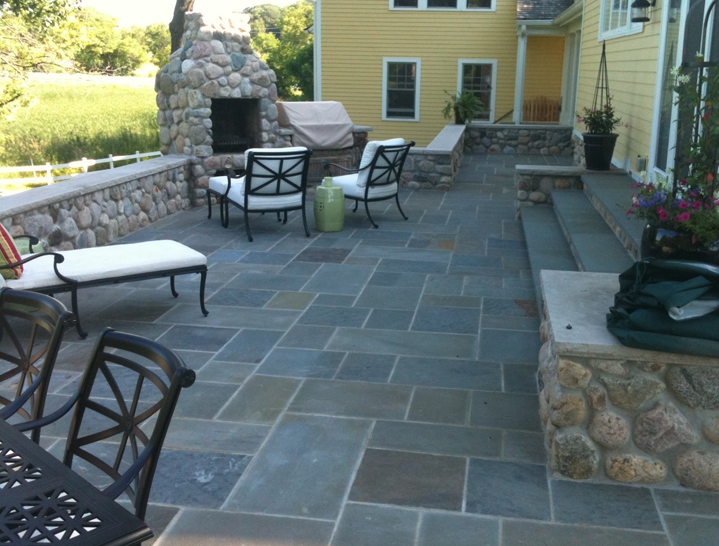Patio stone
Contents |
Introduction
Patios can be a great place to socialise and relax, as well as adding extra value to a property. But there are a lot of things to consider when it comes to having the perfect patio. One of the things that must be considered is the type of stone to use, and there are a lot to choose from.
Sandstone
One of the most popular choices when it comes to choosing stone paver is sandstone. Sandstone is incredibly easy to install as well as being very durable and versatile, making it long-lasting – perfect for the patio environment.
However, it is important to ensure that it is sealed correctly because sandstone succumbs to staining easily. Also, when cleaning sandstone, make sure to stay away from solutions that contain acid or alkaline substances, as this will break down the seal, and possibly the sandstone.
Limestone
Limestone is a beautiful natural stone that is formed from the skeletal remains of organisms like coral. Because of its natural beauty, it is used as a building material all around the world, especially in Mediterranean countries. As well as this, limestone is durable, meaning that it can be used for outdoor floorings, such as patios, as well as indoor flooring.
Limestone comes in an array of different colours, from dark browns to light creams. Because of this, different types of limestone can be arranged so that they can form a beautiful patio. However, when it comes to installing limestone, make sure to use the right equipment, because limestone is very strong, dense, sturdy, and durable, meaning that it can be quite a challenge to install.
Slate
In the UK, slate is a material that is used in anything from roofing and garden accessories to patios and indoor tiling. One of the main benefits of using slate is that it is incredibly strong, meaning that it can withstand the elements when used outdoors. Because of how the slate is oriented, it is incredibly easy to make uniform patio tiles made of slate, which increases the aesthetic of the end result.
Another benefit is that, unlike the other types of stone, it is unaffected by acid, so it can be placed directly onto soil without the risk of any corrosion occurring. Again, just like limestone, slate is incredibly dense, making it difficult to manage and manoeuvre around the garden, so make sure it is known exactly what is wanted so that it isn't necessary to move it around.
Concrete
Concrete is a composite material that is composed of a coarse aggregate material that is bonded with cement. Concrete is used a lot in housing foundations, as well as being used in large-scale infrastructure, predominantly due to its relatively high compressive strength.
Concrete patios have a lot of benefits associated with them, such as the fact that they are easy to maintain and repair, they are incredibly durable, they are very strong, and they can be installed much quicker than the stone patios we mentioned previously.
It is also the most affordable option to have a concrete patio, but make sure to weigh up the options beforehand.
--Heritage Builders Ltd 14:23, 25 Apr 2017 (BST)
Related articles on Designing Buildings Wiki
- BREEAM Hard landscaping and boundary protection.
- Chert.
- Choosing stone.
- Defects in stonework.
- Garden.
- How to lay block paving.
- Inspecting stone sample panels.
- Kerbs.
- Landscape design.
- Masonry.
- Natural stone.
- Natural stone cladding.
- Natural stone flooring.
- Natural stone tiles.
- Pavement.
- Planting.
- Rain garden.
- Types of stone.
Featured articles and news
RTPI leader to become new CIOB Chief Executive Officer
Dr Victoria Hills MRTPI, FICE to take over after Caroline Gumble’s departure.
Social and affordable housing, a long term plan for delivery
The “Delivering a Decade of Renewal for Social and Affordable Housing” strategy sets out future path.
A change to adoptive architecture
Effects of global weather warming on architectural detailing, material choice and human interaction.
The proposed publicly owned and backed subsidiary of Homes England, to facilitate new homes.
How big is the problem and what can we do to mitigate the effects?
Overheating guidance and tools for building designers
A number of cool guides to help with the heat.
The UK's Modern Industrial Strategy: A 10 year plan
Previous consultation criticism, current key elements and general support with some persisting reservations.
Building Safety Regulator reforms
New roles, new staff and a new fast track service pave the way for a single construction regulator.
Architectural Technologist CPDs and Communications
CIAT CPD… and how you can do it!
Cooling centres and cool spaces
Managing extreme heat in cities by directing the public to places for heat stress relief and water sources.
Winter gardens: A brief history and warm variations
Extending the season with glass in different forms and terms.
Restoring Great Yarmouth's Winter Gardens
Transforming one of the least sustainable constructions imaginable.
Construction Skills Mission Board launch sector drive
Newly formed government and industry collaboration set strategy for recruiting an additional 100,000 construction workers a year.
New Architects Code comes into effect in September 2025
ARB Architects Code of Conduct and Practice available with ongoing consultation regarding guidance.
Welsh Skills Body (Medr) launches ambitious plan
The new skills body brings together funding and regulation of tertiary education and research for the devolved nation.
Paul Gandy FCIOB announced as next CIOB President
Former Tilbury Douglas CEO takes helm.
UK Infrastructure: A 10 Year Strategy. In brief with reactions
With the National Infrastructure and Service Transformation Authority (NISTA).
























